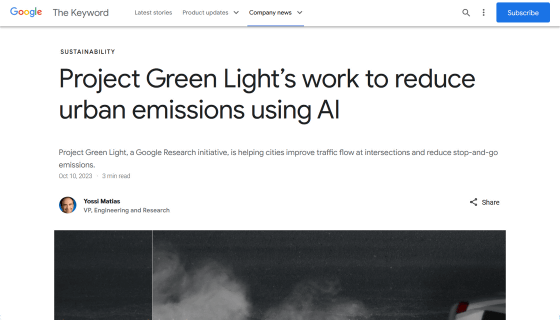Google is promoting a project called ``Green Light'' that uses AI and Google Maps to reduce stops at red lights by 30%

When I was driving a car in the city, I got stuck at a red light many times over a short distance, and I thought, ``I wonder if I spend more time waiting at the light than driving.'' There must be some people who have. Google has announced that it is working on a project called ``Green Light'' that uses AI to improve the timing of traffic lights and reduce the number of stops at red lights.
How Google AI is helping reduce greenhouse gas emissions

Green Light - Google Research
https://sites.research.google/greenlight/
Amazing Project Could Reduce Stops at Red Traffic Lights by 30% : ScienceAlert
https://www.sciencealert.com/amazing-project-could-reduce-stops-at-red-traffic-lights-by-30
Can Google AI help cities reduce traffic emissions? - YouTube
With more than 13 billion cars on the planet, reducing greenhouse gas emissions from cars is critical to combating climate change. However, in reality, cars are not always running, but instead repeat the cycle of running, stopping at a red light, driving for a while after the light turns green, and then stopping at a red light again.

As a result, the amount of greenhouse gas emissions generated at intersections is 29 times that of ordinary roads.

Although the greenhouse gas emissions generated at each intersection are small, considering that there are intersections all over the world, reducing unnecessary stops at intersections can reduce greenhouse gas emissions by a huge amount. Masu.

Therefore, Google is working on a project called ``Green Light'' that combines AI technology and Google Maps data to improve the timing of traffic light switching.

For many urban transportation engineers, obtaining the data to optimize traffic light transition timing requires the labor and expense of installing expensive sensors and manually counting the number of vehicles passing. Therefore, the Google Research team uses traffic trend data collected by Google Maps installed on each driver's smartphone.

Green Light uses this data to build an AI-based model of the interaction between traffic and signal timing, and then makes optimized recommendations for signal switching timing.

Green Light can analyze thousands of intersections simultaneously, and urban traffic engineers can see results within weeks.

Another advantage is that there is no need to install additional infrastructure at traffic lights, as data collection uses smartphones (Google Maps) that many people already have.

Green Light has already been introduced in 12 cities on four continents: Seattle, Rio de Janeiro, Manchester, Hamburg, Budapest, Haifa, Abu Dhabi, Hyderabad, Bangalore, Kolkata, Jakarta, and Bali, and has optimized traffic lights at a total of 70 intersections. . Google intends to expand Green Light to more cities, and municipalities that want to participate will need to sign up for

Early numbers collected by Google show that Green Light could reduce stops at red lights by 30% and reduce greenhouse gas emissions by 10%. David Atkin, Analytics and Reporting Manager at Transport for Manchester in the UK, said: 'Green Light helps identify previously hidden opportunities and where there is potential benefit from changing signal timing. 'This was a valuable insight for Manchester, which has 2,400 traffic lights.'
Related Posts:







